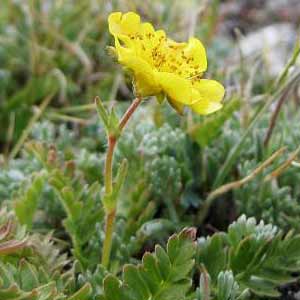Geum rossii
(synonym of Geum rossii var. depressum)
Geum canadense
Ross' avens
benoîte du Canada, white avens
4–28 cm, glabrous or downy, hairs to 1 mm, sometimes septate-glandular.
30–100 cm, glabrate to downy, hairs to 1.5 mm, sometimes glandular.
basal 3–13 cm, blade pinnate to interruptedly pinnate, major leaflets 13–26, alternating with 0–14 minor ones, terminal leaflet slightly larger than major laterals;
cauline 0.7–2 cm, stipules adnate to leaf, indistinguishable from pair of lobes, blade bractlike, not resembling basal, alternate, simple, pinnatifid to 3-fid.
basal 10–25 cm, blade simple or pinnate, major leaflets 3–5, plus 0–4 minor basal ones, terminal leaflet larger than major laterals;
cauline 3–8 cm, stipules ± free, 4–13 × 1–7 mm, blade 3-foliolate or simple and 3-lobed to unlobed.
1–3(–4)-flowered.
3–15-flowered.
woolly, sometimes glandular.
densely hairy, hairs of varying lengths, few long stiff ones, sometimes glandular.
erect;
epicalyx bractlets 1.5–7 mm;
hypanthium green, slightly purple-tinged to strongly purple;
sepals erect to erect-spreading, 3–10 mm;
petals spreading, yellow, obovate to nearly orbiculate, 5–12(–17) mm, longer than sepals, apex broadly rounded to irregularly emarginate.
erect;
epicalyx bractlets 0.5–1.5 mm;
hypanthium green;
sepals spreading but soon reflexed, 3–6 mm;
petals spreading, white, obovate to oblong, (3–)4–8 mm, ± equal to or slightly longer than sepals, apex rounded.
sessile, glabrous.
sessile, densely bristly, hairs 1–2.3 mm.
wholly persistent, not geniculate-jointed, 2–5(–10) mm, apex not hooked, glabrous throughout or pilose only at base.
geniculate-jointed, proximal segment persistent, 2–8 mm, apex hooked, usually glabrous, sometimes sparsely hairy or stipitate-glandular, distal segment deciduous, 1–2 mm, pilose in basal 1/2, hairs much longer than diam. of style.
= 56.
= 42.
Geum rossii
Geum canadense
The variability accommodated here in Geum rossii was distributed by earlier monographers such as P. A. Rydberg (1913b) and F. Bolle (1933) among a half dozen species. W. Gajewski (1957) reduced them to two species, G. rossii and G. turbinatum; most recent taxonomists have recognized the two taxa as subspecies or varieties of a single species. The large geographic discontinuity between the Rocky Mountain and arctic ranges makes it easy for those wishing to follow this tradition. No one morphologic character or combination of characters neatly separates the arctic plants from those of the Rockies.
Where their ranges overlap in Alaska, Geum rossii hybridizes with G. calthifolium to form sterile plants known as G. ×macranthum (Kearney ex Rydberg) B. Boivin; see discussion under 4. G. schofieldii.
(Discussion copyrighted by Flora of North America; reprinted with permission.)
Varieties and forms have been described in an effort to classify the variation encompassed in Geum canadense. In the eastern half of the United States, it is by far the most common, widespread, and variable of the Geum species. Nearly all writers of recent floras have not found it worthwhile to apply names to the variants. Perhaps the most distinctive and worthy of further consideration are plants from the southwestern corner of the range in Arkansas, Oklahoma, and Texas. These plants, some of which fit Fernald and Weatherby’s description of var. texanum, bloom from late March through May, significantly earlier than the rest of the species, which typically flowers after June first, even in the other southern states.
Geum canadense hybridizes with G. urbanum (= G. ×catlingii J.-P. Bernard & R. Gauthier); see discussion under 15. G. urbanum.
Geum album J. F. Gmelin is a superfluous name that pertains here.
(Discussion copyrighted by Flora of North America; reprinted with permission.)
- Local floras:
BC,
OR,
WA
- Local Web sites:
CalFlora,
CalPhotos,
Flora NW,
PNW Herbaria
WildflowerSearch
iNaturalist (observations)
USDA Plants Database
- LBJ Wildflower Center
- SEINet
- Plants of the World Online
- Encyclopedia of Life
- Wikipedia
- Google Image Search
- Local Web sites:
Go Botany,
IL Wildflowers,
KS Wildflowers,
LA Plants,
MD Biodiversity,
MI Flora,
MN Wildflowers,
MO Plants,
PNW Herbaria
WildflowerSearch
iNaturalist (observations)
USDA Plants Database
- LBJ Wildflower Center
- SEINet
- Plants of the World Online
- Encyclopedia of Life
- Wikipedia
- Google Image Search
